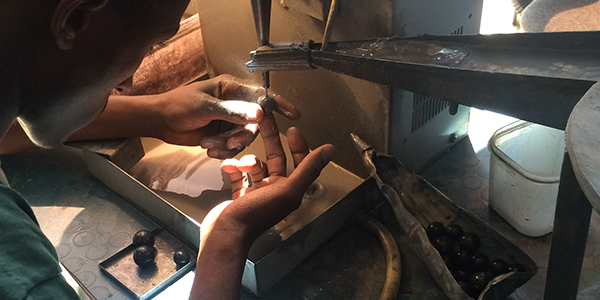Jewellery industry supply chain transparency is essential for responsible business conduct. As customers and consumers of luxury products demand accountability and social impact through purchases, more businesses are beginning to see the competitive, reputational and risk management benefits.
Supply chain due diligence has moved away from pure product-orientated logistics for jewellery companies; as reports like ‘The Hidden Cost of Jewelry’ by Human Rights Watch show, it is of great importance to stakeholder, shareholder, and customer confidence.
Transparency is also essential to the economies, security, and development of countries. Governments around the world have invested in the Extractive Industries Transparency Initiative, a Standard that serves as a tool for countries to improve the management of their oil, gas and mining sectors. Various mechanisms, including the Global Reporting Initiative, the United Nations Guiding Principles on Business and Human Rights (UNGPs), and Fashion Revolution, exist to enable and incentivise business and sector governance.

According to sustainable fashion initiative ‘Common Objective’, a transparent sector would mean businesses:
- Map their supply chains
- Publish details on their supply chains (or, at least, the provenance of their suppliers)
- Publish their policies
- Proactively communicate risk management, incidents, remedy, and improvement programmes with stakeholders
- Report social, environmental, and financial results
The Human Rights Watch report revealed how jewellery industry supply chain transparency is uncommon. Most of the ten jewellery brands analysed in the report had little knowledge of their supply chains beyond their immediate, or ‘Tier 1’, suppliers. We believe this to be common within consumer-facing jewellery companies, regardless of size.
There are many compelling reasons for jewellery companies to increase the transparency of their supply chains, including:
- Building and retaining customer loyalty
- Market differentiation and competitive advantage in a consumer climate of high expectations for authenticity and positive social outcomes
- Building resilient, diverse, and more valuable supply chains that are better managed
- Fulfil obligations under international soft and hard laws, including the UNGPs and the OECD Due Diligence Guidance for Responsible Supply Chains of Minerals from Conflict-Affected and High-Risk Areas
- Avoid potential reputation damage through exposé
So what is stopping the jewellery industry from embracing transparency?
Maintaining the status quo will undoubtedly be the preference of mineral traders, manufacturers and refiners who are comfortable benefitting from old systems of business based on assured opacity. Mineral supply chains and sectors are products of history; the way they function today has been informed by which practices were advocated and tolerated in the past. In some sectors, transparency has been championed by influential producers like BHP, and so has become a common practice.

In other sectors, like the diamonds, the move towards transparency has been slow, hampered by decades of cartelisation that discouraged accountability, progress, and innovation. The gold industry has only recently acknowledged the need for supply chain due diligence for the purpose of risk management.
Secondly, the legacy structures and institutions of the diamond and gold industries can make transparency and traceability seem difficult, or impossible, to achieve. Because of this, misinformation is often rife. In our years working in jewellery, we have seen precious mineral and jewellery companies defend their lack of transparency because of any number of perceived, often insubstantial, threats. Some of the most common perceived threats, and our suggestions to counter them, follow:
“Disclosing suppliers is commercially sensitive and competitively disadvantageous.”
Use a business-friendly approach to supply chain mapping to help manage sensitivities, including assessing the risks and benefits of supplier engagement process and supply chain disclosure.
“If we’re going to publish our policies, they have to be good. We don’t have the capacity or senior support to invest in good policies and procedures for managing risk and doing due diligence.”
Various institutions, like Fairtrade, the OECD, and the European Commission have guidance on how to create good policies for risk management.
“Proactively communicating on incidents that may arise, and our improvement programmes, is risky – if we disclose issues we might damage our brand or products.”
Mainstreaming communications across due diligence programmes is important. See this as an opportunity for competitive advantage – make sure you do it well.
“Reporting on social and environmental performance requires investment in measuring and evaluation, legal, and communications capacity and procedures.”
Many tools for risk and sustainability assessment at country and mine site level exist. These help businesses know how they are doing and allow them to report clearly and easily.

Transparency requires traceability and new business models. In some existing models, diamonds and gold are commoditised, mixed, anonymised, and provenance is lost as a way of keeping costs down. As precious metals and gems are the primary material cost associated with every jewellery product, some companies may be fearful of increased costs associated with giving provenance to inputs. To counter this, there must be value in provenance. Companies like Gübelin Gem Laboratory, a client of Levin Sources, is helping build such value through its Provenance Proof initiative – a scalable tool that could increase marketability of minerals with demonstrable provenance and a backstory of positive social and environmental impact.
The barriers and challenges to increase transparency are surmountable. Jewellery companies large and small have the power to drive the transparency agenda through their operations and business relations. Indeed, it is the responsibility of businesses to embrace transparency to generate positive social and environmental impacts throughout minerals sectors. Without demand, and thus pressure, from the private sector, the worst practitioners in mining and manufacturing can continue to operate unchecked for the sake of profit and with a disregard for human rights.
The next blog in this series, The Traceable Supply Chain Challenge, will expand on how jewellery companies can bring transparency to their supply chains in a practical, cost-effective manner.
Recommended reading:
OECD Due Diligence Guidance for Responsible Business Conduct
UN Guiding Principles on Business and Human Rights
The GIFF Project: International Dialogue Report, Paris, 13 May 2016
Nielsen, 'Green Generation: Millennials Say Sustainability is a Shopping Priority'
Mineral Supply Chain Transparency: Soft and Hard Laws on Supply Chains Due Diligence and the Rise of Public-Private Partnerships (purchase as part of 'Building New Bridges Between Business and Society')
The 'Better Business in the Jewellery Sector' blog series is written by jewellery, due diligence, and responsible sourcing experts from Levin Sources and edited by Jack Cooper. Estelle Levin-Nally provides editorial oversight, analysis and additional contributions.



